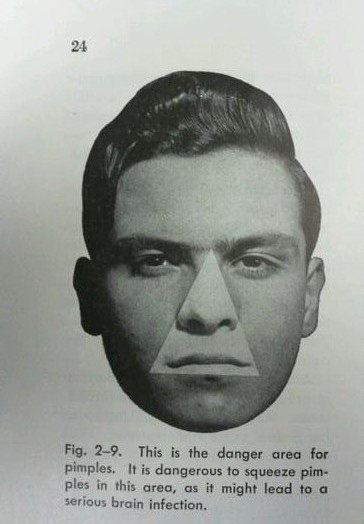health
Kill everyone now! Condone first degree murder! Advocate cannibalism! Eat shit!

{ A human brain overrun with cysts from Taenia solium, a tapeworm that normally inhabits the muscles of pigs. | Discover | full story }
The harp that once or twice

{ Why do some people enjoy the taste of broccoli while others find it bitter and unpleasant? Why do some seek out spicy and tangy meals on a restaurant’s menu while others stick with the bland and familiar? New research is uncovering the neurobiological and genetic sources of taste preferences, which can influence not just eating habits but also health. | Brain Facts | full story }
Piano again. Cowley it is. Way he sits in to it, like one together, mutual understanding.
{ This surgeon has performed 200 penis enlargement operations in the last year alone. But are men getting what they pay for? | Independent | full story }
Coming out with a whopper now. Rhapsodies about damn all.
One of the nightmare scenarios for modern society is the possibility of a global flu pandemic like the 1918 Spanish influenza which infected about a quarter of the global population and killed as many as 130 million of them.
An important question for policy makers is how best to limit the spread of such a disease if a new outbreak were to occur. (The Spanish flu was caused by the H1N1 flu virus that was also responsible for the 2009 swine flu outbreak.)
One obvious idea is to close international airports to prevent, or at least dramatically reduce, the movement of potentially infected individuals between countries. But is this the best approach?
Today, Jose Marcelino and Marcus Kaiser at Newcastle University in the UK, provide an answer. They say a better approach is to cut specific flights between airports because it can achieve the same reduction in the spread of the disease with far less drastic action.
‘Is it technically a hangover if you’re still drunk?’ –Patrick Harrison

The settings for a person’s biological clock might provide clues to when, during the day, he or she will be more active. What’s more, these same settings could be linked to what time of day a person might die, a new study finds.
Understanding the biological basis of these built-in, or circadian, clocks “could lead to products that eventually allow us to shift the clock forwards or backwards,” says Philip De Jager, a neurologist with Harvard Medical School in Boston. He and his colleagues describe their work online April 26 in Annals of Neurology.
Being able to alter these clocks could prove useful for shift workers, such as pilots, who might face trouble working against their intrinsic daily rhythms, De Jager adds. And patients can be better cared for if doctors know what times of day are most critical.
Previously, scientists have shown that many genes are involved in regulating people’s inherent daily wake and sleep patterns. Disruptions to this natural circadian rhythm are often linked to serious health conditions, including diabetes.
photo { Sean and Seng }
Schlimmbesserung, German, ‘an effort to make something better that actually makes things worse’

A new study suggests that, by disrupting your body’s normal rhythms, your alarm clock could be making you overweight.
The study concerns a phenomenon called “social jetlag.” That’s the extent to which our natural sleep patterns are out of synch with our school or work schedules. Take the weekends: many of us wake up hours later than we do during the week, only to resume our early schedules come Monday morning. It’s enough to make your body feel like it’s spending the weekend in one time zone and the week in another. […]
Previous work with such data has already yielded some clues. “We have shown that if you live against your body clock, you’re more likely to smoke, to drink alcohol, and drink far more coffee,” says Roenneberg. […]
The researchers also found that people of all ages awoke and went to bed an average of 20 minutes later between 2002 and 2010. Work and school times have remained the same, meaning that social jetlag has increased during this period.
photo { Weegee in his apartment, police radio by his bedside }
‘In recent years, many men of science have come to realize that the scientific picture of the world is a partial one.’ –Aldous Huxley

Despite 28 years of research, there is still no vaccine that provides effective protection against HIV, and in that time around 25 million people have died of HIV-related causes. To understand why creating a vaccine is so hard, you need to understand HIV. This is no ordinary virus. […] The virus is the most diverse we know of. It mutates so rapidly that people might carry millions of different versions of it, just months after becoming infected. HIV’s constantly changing form makes it unlike any viral foe we have tried to thwart with a vaccine. […]
Vaccines train the immune system to recognise part of a virus, creating a long-term armada of antibodies that seek and destroy the invader, should it ever show its face. For HIV, the most obvious target is gp120, the surface protein that it uses to attach itself to human cells. But gp120 also constantly changes shape, making it difficult to recognise. It also comes in clusters of three that are shielded by bulky sugar molecules, hiding it from the immune system.
On top of that, HIV targets immune cells, the very agents that are meant to kill it. And it can hide for years by shoving its DNA into that of its host, creating a long-term reservoir of potential infection.
So, creating an HIV vaccine is like trying to fire a gun at millions of shielded, moving targets. Oh, and they can eat your bullets.
photo { Nan Goldin }
Why aren’t we giving plastic surgery to kids yet? Some of them look like shit.
The ‘body clock’ or circadian rhythms controls things like alertness, sleep patterns, appetite and hormones, and travelling across time zones or working nights can disturb it. […]
The researchers found that two nuclear receptors (receptors that sense hormones), called REV-ERB-α and REV-ERB-β, control the circadian expression of core circadian clock and lipid homeostatic gene networks. Not getting enough sleep puts you at increased risk of obesity, diabetes and related metabolic disorders.
Extraordinary the interest they take in a corpse

Mummies were stolen from Egyptian tombs, and skulls were taken from Irish burial sites. Gravediggers robbed and sold body parts.
“The question was not, ‘Should you eat human flesh?’ but, ‘What sort of flesh should you eat?’ ” says Sugg. […]
Blood was procured as fresh as possible, while it was still thought to contain the vitality of the body. This requirement made it challenging to acquire. The 16th century German-Swiss physician Paracelsus believed blood was good for drinking, and one of his followers even suggested taking blood from a living body. […]
As science strode forward, however, cannibal remedies died out. The practice dwindled in the 18th century, around the time Europeans began regularly using forks for eating and soap for bathing. But Sugg found some late examples of corpse medicine: In 1847, an Englishman was advised to mix the skull of a young woman with treacle (molasses) and feed it to his daughter to cure her epilepsy. (He obtained the compound and administered it, as Sugg writes, but “allegedly without effect.”)
photo { Volgareva Irina }
Smoke mermaids, coolest whiff of all. Hair streaming: lovelorn. For some man. For Raoul.

In a Dutch study performed by Pieter van Baal and colleagues, the authors compared the annual and lifetime health care costs of three cohorts, namely the obese, the smokers, and the healthy living people. […]
The lifetime costs for an obese person amounted to € 399,000, compared to which the smoker comes at a 14% discount of € 341,000, but the healthy living person with a 17% premium at € 468,000.
artwork { Dan Voinea }
Fire walk with me

Sex addiction is big business, there is an American Society of Addictive Medicine that says addiction is a “chronic brain disorder” but this is unsupported by research. There are many clinics where the wealthy (males) can go to be cured. About 900 people have been certified as sex addiction therapists (CSAT) at a cost of about $5000. Chapter 4 covers this well.
Check out Chapter 3, Valley Girl Science, for an interesting view of sex addiction being “like” so many other things. If you are feeling sexy, go to Chapter 6. Chapter 13 is “The Ignored Aspects of Masculinity” where the sex addiction field focuses on men as intrinsically selfish, focused on “scoring” and virility. It ignores the part of men that are seeking love and trying their best to please their partners. This is an especially powerful chapter. Actually, there are no chapters in this book that you would want to skip over.
{ Electronic Journal of Human Sexuality | Continue reading }
photo { Lee Friedlander, R. O. Blechman, New York City, 1968 }
This drill will open a hole in the universe

Surgery is a profession defined by its authority to cure by means of bodily invasion. The brutality and risks of opening a living person’s body have long been apparent, the benefits only slowly and haltingly worked out. Nonetheless, over the past two centuries, surgery has become radically more effective, and its violence substantially reduced — changes that have proved central to the development of mankind’s abilities to heal the sick.
The first volume of the New England Journal of Medicine and Surgery, and the Collateral Branches of Science, published in 1812, gives a sense of the constraints faced by surgeons, and the mettle required of patients, in the era before anesthesia and antisepsis.
artwork { Picasso, Standing Female Nude, 1910 }
While you were sleeping

After a busy week with short nights, many use the weekend to make up for lost hours of sleep. Not a healthy habit, says researcher Paulien Barf. On the long run it could result into the development of obesity or even diabetes. (…) Previous studies have shown that sleeping to recover from sleep shortage is of importance for a variety of physiological processes.
photo { Lee Friedlander, Nude, 1980 }
I see you have moved the piano

From what I previously understood, people would ingest mushrooms, and if they were in a negative state of mind, they’d have a “bad trip.” If they were with friends, with other people tripping, they were more likely to have a “good trip.” Aspects of these trips seemed to include lots of visual and auditory hallucinations: “halos” glowing around light sources, warping colors, maybe some synesthesia.
So I just figured that magic mushrooms must hyper-activate the parts of the brain that perceive color and sound, to the point where people perceive things that aren’t even there.
However, recent research out of the U.K. says that, surprisingly, I’ve got it all backwards. (…)
Within a minute or two, the test subjects started to feel the effects of the psilocybin, and the researchers gave them fMRIs during their trips. Surprisingly to me, and to the scientists, brain activity and blood flow decreased by up to 20% during the influence of the drug, and these decreases were proportional to the reported intensity of the trip. (…) The thought behind this finding is that when people do shrooms, pathways in the brain that would normally restrict cognition are temporarily turned off, allowing people to cognate at higher levels than ever before. Some of these same cognition-restraining pathways are overactive in cases of depression, but I won’t go so far as to suggest shrooms as a treatment for depressive disorders.
photo { Stefan Heyne }
‘I ran my life exactly as I wanted to, all the time. I never listened to anybody.’ –Michael Caine

Albert Tirrell and Mary Bickford had scandalized Boston for years, both individually and as a couple, registering, as one observer noted, “a rather high percentage of moral turpitude.” Mary, the story went, married James Bickford at 16 and settled with him in Bangor, Maine. They had one child, who died in infancy. Some family friends came to console her and invited her to travel with them to Boston. Mary found herself seduced by the big city. (…)
James came to Boston at once, found Mary working in a house of ill repute on North Margin Street and returned home without her. She moved from brothel to brothel and eventually met Tirrell, a wealthy and married father of two. He and Mary traveled together as man and wife, changing their names whenever they moved, and conducted a relationship as volatile as it was passionate; Mary once confided to a fellow boarder that she enjoyed quarreling with Tirrell because they had “such a good time making up.” (…)
Choate kept that case in mind while plotting his defense of Tirrell, and considered an even more daring tactic: contending that Tirrell was a chronic sleepwalker. If he killed Mary Bickford, he did so in a somnambulistic trance and could not be held responsible.
photo { Linus Bill }
I can’t lie to you about your chances, but… you have my sympathies.

Exercise, done right, has been found to reduce the risk of dying from any cause by at least one third with a 9% reduction for every one hour of vigorous exercise performed per week. To be fair, studies which calculate such risks are inherently flawed. They assess exercise through questionnaires, which makes it difficult to reliably judge the amount and intensity of exercise, and whether people stick with a given exercise level and for how long. That’s why I like to look at the exercise-health correlation using fitness as the marker. Because fitness is a direct consequence of exercise, and it is something we can objectively measure in the lab.
A fit 45 years old man has only one quarter the lifetime risk of dying from cardiovascular causes compared to his unfit peer. And 20 years later, at the age of 65, being fit means having only half the risk of an unfit 65-year old. (…)
The association of fitness with cancer is not as well researched as with cardiovascular disease. But the available data clearly point to a substantial effect. In a study performed in 1300 Finnish men who were followed for 11 years, the physically fit ones, when compared to their least fit peers, had a 60% reduced risk of dying from non-cardiovascular causes, which means mostly cancer.
photo { Jason Florio }
Sometimes less is more. Yeah, if you are really fucking bad at math.

Recent years has seen the emergence of a popular ‘raw food’ movement. Dehydrating food to make it palatable, raw-foodies argue that cooking food destroys valuable vitamins and enzymes, rendering it nutritionally impoverished. It sounds logical, but – especially with vegetables – is often false. Many vegetables actually gain nutritional value after careful cooking or steaming. Furthermore, a strict vegan raw food diet is not good for long term health. (…)
Red meat is notable in that it contains a good source of B-vitamins that are essential for healthy muscles, skin and nerves. It also contains iron and other important minerals. Like most things however, steak should be in moderation as a high intake is associated with colon cancer and other health nasties. (…)
• The longer steak is cooked, the fewer vitamins it contains
• Cooking meat in water reduces its vitamin content further (the vitamins leech out into the water)
• The levels of iron and zinc increase with cooking
• Fat levels drop with cooking
photo { Thomas Demand, Junior Suite [Whitney Houston’s last supper], 2012 | NY Times | DesignBoom }
So a fellow coming in late can see what turn is on and what turns are over

If you don’t die from an accident, a serious infection or a cancer, you’ll live as long as your arteries let you. And how long they let you is all in your hands. I know this sounds over-simplified, but it’s biomedical knowledge in a nutshell. Let’s look at what happens in and to your arteries and what that means for keeping them in mint condition.
You may have thought about your arteries as elastic tubes, which transport blood to where its oxygen and nutrient load is needed. But there is more to it. For example, there is this very thin lining which separates the muscular elastic wall of the arteries from the blood stream. This lining is called the endothelium, and it is where the difference is made between lifestyle and death style.
photo { Nick Meek }







